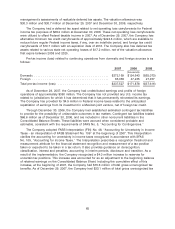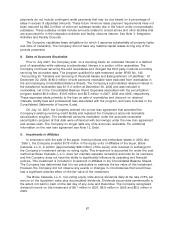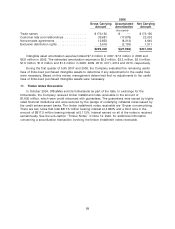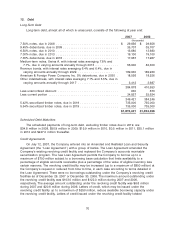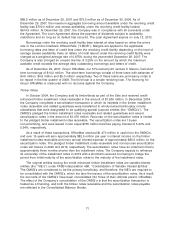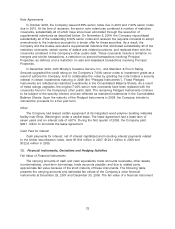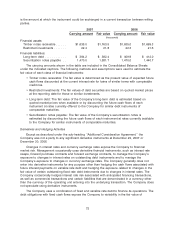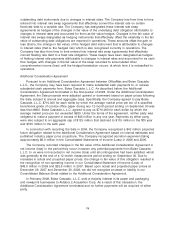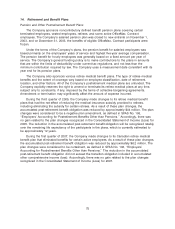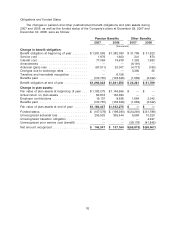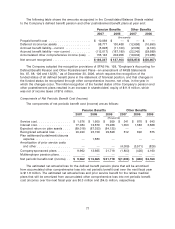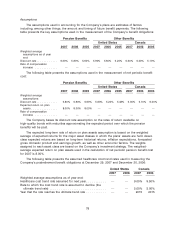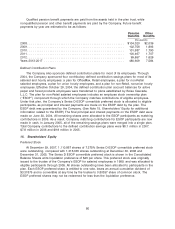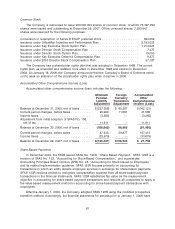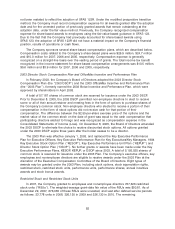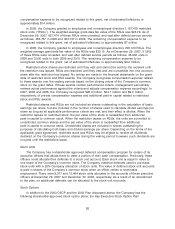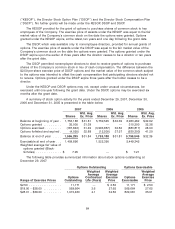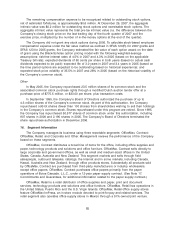OfficeMax 2007 Annual Report Download - page 79
Download and view the complete annual report
Please find page 79 of the 2007 OfficeMax annual report below. You can navigate through the pages in the report by either clicking on the pages listed below, or by using the keyword search tool below to find specific information within the annual report.14. Retirement and Benefit Plans
Pension and Other Postretirement Benefit Plans
The Company sponsors noncontributory defined benefit pension plans covering certain
terminated employees, vested employees, retirees, and some active OfficeMax, Contract
employees. The Company’s salaried pension plan was closed to new entrants on November 1,
2003, and on December 31, 2003, the benefits of eligible OfficeMax, Contract participants were
frozen.
Under the terms of the Company’s plans, the pension benefit for salaried employees was
based primarily on the employees’ years of service and highest five-year average compensation.
The pension benefit for hourly employees was generally based on a fixed amount per year of
service. The Company’s general funding policy is to make contributions to the plans in amounts
that are within the limits of deductibility under current tax regulations, and not less than the
minimum contribution required by law. The Company uses a measurement date consistent with its
year end for its pension plans.
The Company also sponsors various retiree medical benefit plans. The type of retiree medical
benefits and the extent of coverage vary based on employee classification, date of retirement,
location, and other factors. All of the Company’s postretirement medical plans are unfunded. The
Company explicitly reserves the right to amend or terminate its retiree medical plans at any time,
subject only to constraints, if any, imposed by the terms of collective bargaining agreements.
Amendment or termination may significantly affect the amount of expense incurred.
During the third quarter of 2005, the Company made changes to its retiree medical benefit
plans that had the net effect of reducing the medical insurance subsidy provided to retirees,
including eliminating the subsidy for certain retirees. As a result of these plan changes, the
accumulated post-retirement benefit obligation was reduced by approximately $44 million. The plan
changes were considered to be a negative plan amendment, as defined in SFAS No. 106,
‘‘Employers’ Accounting for Postretirement Benefits Other than Pensions.’’ Accordingly, there was
no gain related to the plan changes recognized in the Consolidated Statement of Income (Loss) for
2005. The reduction in the accumulated post-retirement benefit obligation will be recognized ratably
over the remaining life expectancy of the participants in the plans, which is currently estimated to
be approximately 12 years.
During the first quarter of 2007, the Company made changes to its Canadian retiree medical
benefit plan that eliminated benefits for certain active employees. As a result of these plan changes,
the accumulated post-retirement benefit obligation was reduced by approximately $6.2 million. The
plan changes were considered to be curtailment, as defined in SFAS No. 106, ‘‘Employers’
Accounting for Postretirement Benefits Other than Pensions.’’ The reduction in the accumulated
post-retirement benefit obligation did not exceed the transition obligation included in accumulated
other comprehensive income (loss). Accordingly, there was no gain related to the plan changes
recognized in the Consolidated Statement of Income (Loss) for 2007.
75


